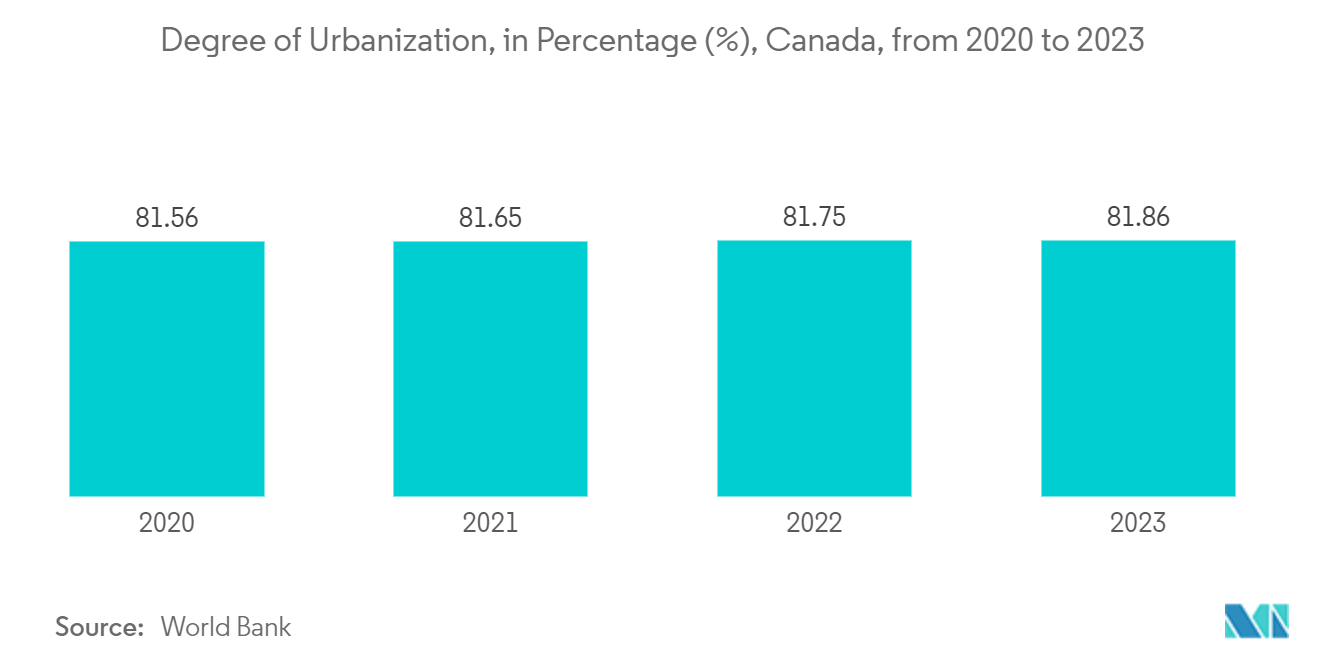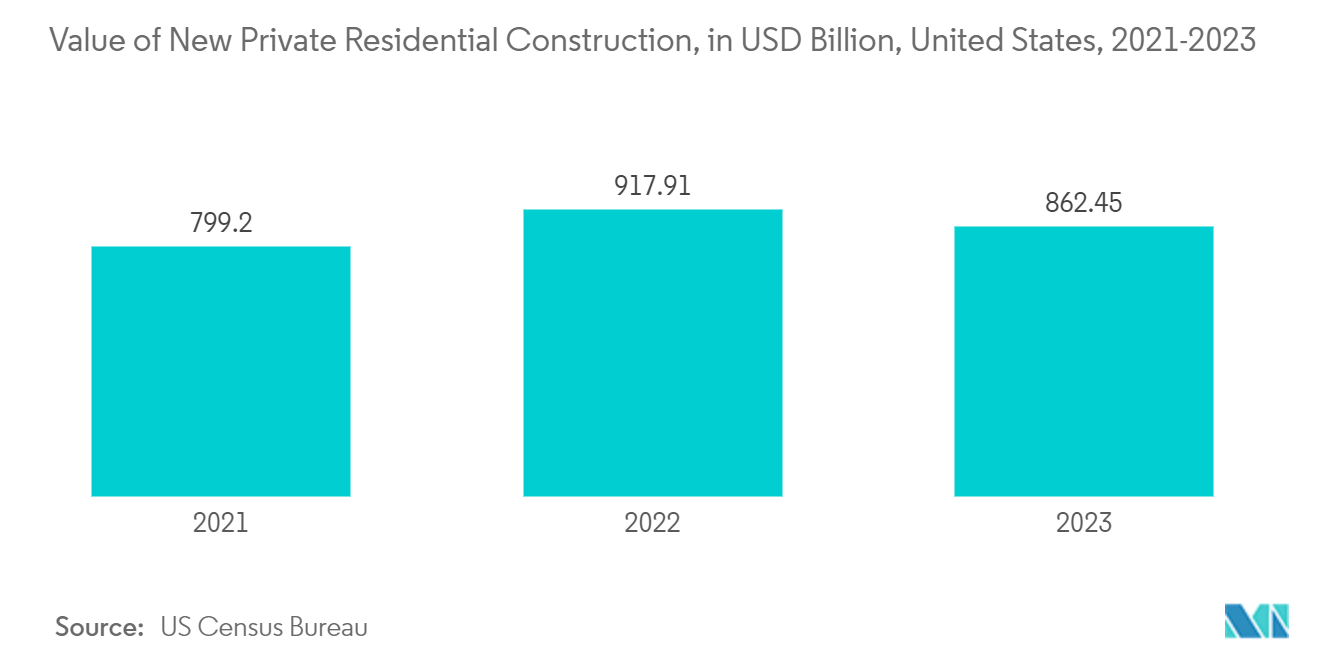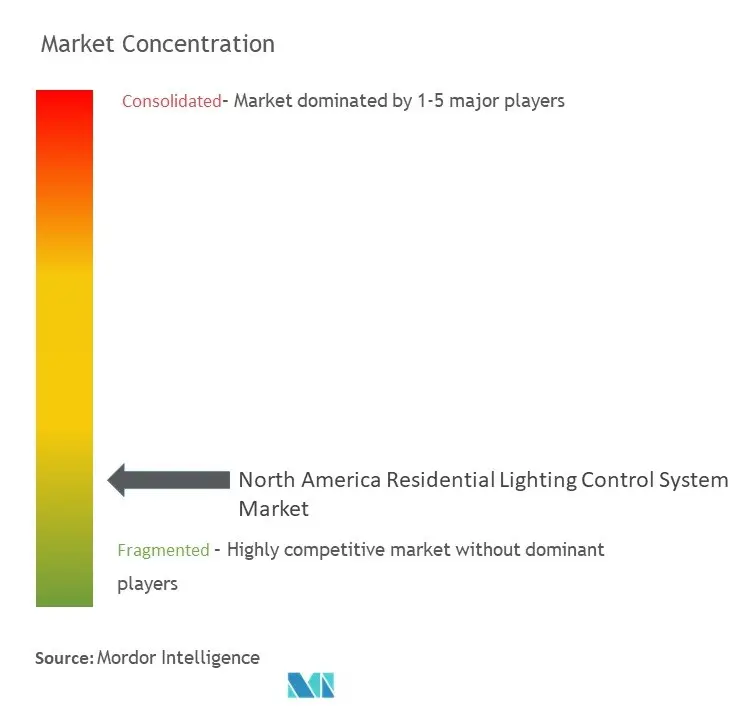North America Residential Lighting Control System Market Size

| Study Period | 2019 - 2029 |
| Base Year For Estimation | 2023 |
| Market Size (2024) | USD 6.91 Billion |
| Market Size (2029) | USD 14.20 Billion |
| CAGR (2024 - 2029) | 15.50 % |
| Market Concentration | Low |
Major Players
*Disclaimer: Major Players sorted in no particular order |
North America Residential Lighting Control System Market Analysis
The North America Residential Lighting Control System Market size is estimated at USD 6.91 billion in 2024, and is expected to reach USD 14.20 billion by 2029, growing at a CAGR of 15.5% during the forecast period (2024-2029).
A lighting control system integrates communication between different inputs and outputs for lighting control, typically through one or more central computing devices. These systems find extensive application in illuminating indoor and outdoor spaces in commercial, industrial, and residential settings.
- LED lighting and its control systems represent a highly energy-efficient technology poised to revolutionize the lighting landscape in the United States. Residential LEDs, particularly those with ENERGY STAR ratings, consume at least 75% less energy and boast a lifespan of up to 25 times longer than traditional incandescent lighting. The widespread adoption of LED lighting and control systems holds significant promise for energy conservation in the United States.
- North America's LED and smart lighting sector is witnessing robust growth, with a promising trajectory ahead. Government initiatives aimed at curbing energy consumption and greenhouse gas emissions have spurred the adoption of energy-efficient lighting solutions, notably smart lighting systems, through incentive programs.
- According to David Buerer, director of Product Management for Controls, Leviton, in 2024, key trends in the lighting controls market encompass deeper integration with smart building systems, a heightened emphasis on user-friendly solutions, escalating demands for lighting controls in energy codes, and a persistent drive for energy efficiency and sustainability. Notably, rebates for networked lighting controls play a pivotal role in spurring retrofits, bolstering awareness, enhancing ROI, boosting adoption rates, and fortifying energy efficiency through advanced lighting controls.
- Lighting significantly contributes to energy consumption in buildings. According to the US Department of Energy, ENERGY STAR-rated products consume at least 75% less energy and have a lifespan of up to 25 times longer than traditional incandescent lighting in homes. LEDs, as a highly energy-efficient lighting technology, hold the promise of reshaping the lighting landscape in the United States.
- Amid the current economic climate, many semiconductor firms are scaling back their capital investments. The US market is proving distinct, with challenges that set it apart from other global regions. Notably, semiconductor projects face setbacks, with delays attributed to labor and material scarcities. Fluctuating prices of raw material commodities add an extra layer of unpredictability to the industry. Historically, chip production has been concentrated in Southeast Asia and China. However, the United States now only contributes roughly 12% to the global semiconductor output.
North America Residential Lighting Control System Market Trends
Hardware Holds Major Share
- Residential lighting fixtures, like LED bulbs, downlights, track lights, and under-cabinet lights, rely on LED drivers. These drivers supply power and regulate current, ensuring LEDs function optimally and deliver the desired brightness. In decorative lighting, strip, rope, and LED tape lights with LED drivers enable color customization, dimming, and dynamic lighting effects.
- According to the World Bank, more than 80% of Canada's total population currently resides in urban areas. In recent years, Canada's rate of urbanization has been on the rise, with advancements in technology reducing the need for labor in the agriculture and energy sectors, and the service industries in Canada experiencing growth of urban population, along with increasing building permits, and new home constructions are expected to drive the growth of indoor lighting products across the region,
- Moreover, Daylight sensors are pivotal in adhering to building codes and standards set by prominent organizations, including ASHRAE 90.1, IECC, the Lighting Controls Association (LCA), and LEED. These sensors automatically modulate artificial lighting in response to natural daylight, effectively curbing energy consumption.
- Notably, ASHRAE 90.1 and IECC mandates underscore the adoption of daylight harvesting techniques for energy reduction. Buildings can readily align with these stringent codes by seamlessly integrating these sensors into lighting systems. The Lighting Controls Association (LCA) actively advocates leveraging advanced controls, such as daylight sensors, to bolster energy conservation efforts. The above instances are expected to create more demand for Indoor LEDs in the coming years.
- From roughly 1.4 billion units installed in 2017 to over 7.9 billion units in 2035, the number of LED light installations in the United States is rising. By 2025, 56% of residential are expected to have LED lighting installed. Dimmers play a crucial role in reducing energy consumption, as dimmer switches offer a significant benefit: energy savings. Consumers have a higher chance to save up to 25% on their energy costs by dimming their lights by just 25%.

Wireless Segment to Witness Major Growth
- Wireless controls, utilizing radio waves or other wireless methods, eliminate the need for control wiring. This feature is especially appealing when integrating advanced controls into pre-existing structures. Control input devices can draw power from an internal battery or harness energy from sources like ambient light, temperature variations, or even the mechanical energy generated by a switch being toggled. These devices transmit control signals wirelessly from a transmitter to a receiver in a lighting controller. The controller is typically situated at the luminaire, a junction box, or a panel.
- Wireless lighting control technology encompasses Zigbee, Z-Wave, and Bluetooth Mesh. While Z-Wave and Bluetooth Mesh find their niche in home automation, Zigbee is carving a path in residential building markets. Its appeal lies in its resilience and scalability, boasting the ability to accommodate a virtually limitless number of control nodes across a lighting setup.
- The primary allure of wireless systems lies in their straightforward installation, potentially leading to reduced labor costs. This advantage shines, particularly in retrofit scenarios, where replacing an existing wired system would prove both time-consuming and cost-prohibitive.
- With the increase in residential and multifamily housing sector construction, smart home technology seamlessly integrates wireless lighting control. This integration offers landlords and tenants convenience and energy savings and allows for personalized lighting catering to individual lifestyles. Such adaptability positions wireless lighting control systems as invaluable assets, enhancing functionality, aesthetics, and the overall user experience across various industries. According to the US Census Bureau, as of 2023, private residential housing construction has reached a value of 862.45 billion USD in the United States.

North America Residential Lighting Control System Industry Overview
The residential lighting control system market in North America is fragmented owing to the presence of large and small players. Some of the players are General Electric Lighting (SAVANT TECHNOLOGIES LLC.), Philips Lighting NV (Signify NV), Eaton Corporation PLC, Honeywell International Inc., and Acuity Brands Inc.
In July 2024, Lutron Electronics, a prominent figure in lighting control and automated shading solutions, unveiled new products under its Caséta lineup. These include a Diva smart dimmer featuring ELV+ technology and Pico paddle remotes, which are now available in five additional colors. These releases cater specifically to professional installers, aiming to streamline the completion of projects involving diverse load types. The company provides clients with an expanded selection, all in the popular paddle-style design.
In March 2024, Legrand's Vantage Lighting Controls unveiled 'Vantage Voice.' This feature integrates voice control into the Vantage InFusionTM System, leveraging Amazon Alexa. It is part of the latest software update, Design Center 4.8. Vantage Voice, now accessible from Design Center 4.8 onwards, enables users to execute scenes using voice commands. Essentially, it emulates a button press to activate and complete a task.
North America Residential Lighting Control System Market Leaders
-
General Electric Lighting (SAVANT TECHNOLOGIES LLC.)
-
Philips Lighting NV (Signify N.V.)
-
Eaton Corporation plc
-
Honeywell International Inc.
-
Acuity Brands, Inc.
*Disclaimer: Major Players sorted in no particular order

North America Residential Lighting Control System Market News
- April 2024 - Lepro, a prominent figure in AI lighting, introduced its groundbreaking LightGPM technology. This innovative system, powered by a Generative Pretrain Model, ensures that smart lights respond to commands and emotions, creating lighting effects tailored precisely to users' moods. Leveraging AI voice and facial recognition, these lights offer unmatched customization.
- January 2024 - Legrand, a global player in electrical wiring devices, unveiled its newest LED dimmer as part of the Radiant Collection. This cutting-edge dimmer stands out for its extensive dimming range, thanks to its sophisticated circuitry that ensures precise light control, addressing common dimming challenges. Designed for seamless compatibility, the dimmer can be used with a wide range of LED bulbs and fixtures, supporting up to 150W at 120VAC.
North America Residential Lighting Control System Market Report - Table of Contents
1. INTRODUCTION
- 1.1 Study Assumptions and Market Definition
- 1.2 Scope of the Study
2. RESEARCH METHODOLOGY
3. EXECUTIVE SUMMARY
4. MARKET INSIGHTS
- 4.1 Market Overview
- 4.2 Industry Value Chain Analysis
- 4.3 Impact of Macro Economic Factors and COVID-19 on the Industry
5. MARKET DYNAMICS
-
5.1 Market Drivers
- 5.1.1 Government Initiatives and Innovative Products for Smart Lighting
- 5.1.2 Sustainability/reduction in Carbon Footprint
-
5.2 Market Restraints
- 5.2.1 Supply Chain Landscape - Rising Semiconductor Shortage
6. MARKET SEGMENTATION
-
6.1 By Deployment
- 6.1.1 Hardware
- 6.1.1.1 LED Drivers
- 6.1.1.2 Sensors
- 6.1.1.3 Switches and Dimmers
- 6.1.1.4 Relay Units
- 6.1.1.5 Gateways
- 6.1.2 Software
-
6.2 By Communication Protocol
- 6.2.1 Wired
- 6.2.2 Wireless
7. COMPETITIVE LANDSCAPE
-
7.1 Company Profiles*
- 7.1.1 General Electric Lighting (SAVANT TECHNOLOGIES LLC.)
- 7.1.2 Philips Lighting NV (Signify NV)
- 7.1.3 Eaton Corporation PLC
- 7.1.4 Honeywell International Inc.
- 7.1.5 Acuity Brands Inc.
- 7.1.6 Cree Lighting USA LLC
- 7.1.7 Lutron Electronics Co. Inc.
- 7.1.8 Legrand North America LLC
- 7.1.9 Leviton Manufacturing Co. Inc.
- 7.1.10 ERG Lighting Inc.
8. MARKET OUTLOOK
** Subject To AvailablityNorth America Residential Lighting Control System Industry Segmentation
A lighting control system integrates communication between lighting control inputs and outputs, facilitated by one or more central computing devices. These systems find extensive application in illuminating residential spaces, both indoors and outdoors.
The North American residential lighting control system market is segmented by deployment (hardware [LED drivers, sensors, switches and dimmers, relay units, gateways], software), and communication protocol (wired, wireless). The market size and forecasts provided are in terms of value (USD) for all the above segments.
| By Deployment | Hardware | LED Drivers |
| Sensors | ||
| Switches and Dimmers | ||
| Relay Units | ||
| Gateways | ||
| By Deployment | Software | |
| By Communication Protocol | Wired | |
| Wireless |
North America Residential Lighting Control System Market Research FAQs
How big is the North America Residential Lighting Control System Market?
The North America Residential Lighting Control System Market size is expected to reach USD 6.91 billion in 2024 and grow at a CAGR of 15.5% to reach USD 14.20 billion by 2029.
What is the current North America Residential Lighting Control System Market size?
In 2024, the North America Residential Lighting Control System Market size is expected to reach USD 6.91 billion.
Who are the key players in North America Residential Lighting Control System Market?
General Electric Lighting (SAVANT TECHNOLOGIES LLC.), Philips Lighting NV (Signify N.V.), Eaton Corporation plc, Honeywell International Inc. and Acuity Brands, Inc. are the major companies operating in the North America Residential Lighting Control System Market.
What years does this North America Residential Lighting Control System Market cover, and what was the market size in 2023?
In 2023, the North America Residential Lighting Control System Market size was estimated at USD 5.84 billion. The report covers the North America Residential Lighting Control System Market historical market size for years: 2019, 2020, 2021, 2022 and 2023. The report also forecasts the North America Residential Lighting Control System Market size for years: 2024, 2025, 2026, 2027, 2028 and 2029.
North America Residential Lighting Control System Industry Report
Statistics for the 2024 North America Residential Lighting Control System market share, size and revenue growth rate, created by Mordor Intelligence™ Industry Reports. North America Residential Lighting Control System analysis includes a market forecast outlook for 2024 to 2029 and historical overview. Get a sample of this industry analysis as a free report PDF download.



